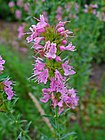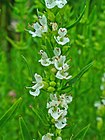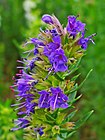Note: This is a project under development. The articles on this wiki are just being initiated and broadly incomplete. You can Help creating new pages.
Difference between revisions of "Hyssopus officinalis - Jufa"
(Created page with "thumb|right|''Jufa'', ''Hyssopus officinalis'', ''hyssop'' '''Jufa''' is a(n) herbaceous plant of the genus Hyssopus native to Southern...") |
(→How to plant/cultivate) |
||
| (17 intermediate revisions by 2 users not shown) | |||
| Line 1: | Line 1: | ||
[[File:Hyssopus officinalis 001.JPG|thumb|right|''Jufa'', ''Hyssopus officinalis'', ''hyssop'']] | [[File:Hyssopus officinalis 001.JPG|thumb|right|''Jufa'', ''Hyssopus officinalis'', ''hyssop'']] | ||
| + | '''Jufa''' is a herbaceous plant of the genus Hyssopus femily. and it is native to Southern Europe, the Middle East, and the region surrounding the Caspian Sea. | ||
| − | + | ==Uses== | |
| + | {{Uses|Anxiety}}, {{Uses|Lower blood pressure}}, {{Uses|Colic}}, {{Uses|Liver disorders}}, {{Uses|Asthma}}, {{Uses|Catarrh}}, {{Uses|Bronchitis}}, {{Uses|Diarrhea}}, {{Uses|Common cold}} | ||
| − | == | + | ==Parts Used== |
| − | + | {{Parts Used|Flowers}}, {{Parts Used|Leaves}}. | |
| − | |||
| − | + | ==Chemical Composition== | |
| + | Volatile oil ,Pinocamphone, Isopinocamphone, Pinenes, Camphene, and terpinene,Hyssopin, Tannin, Flavonoids, Insolic acid, Oleonolic acid, a bitter substance (marrubiin), resin, gum<ref name="chemical composition"/> | ||
| − | == | + | ==Common names== |
| − | + | {{Common names|kn=|ml=|sa=|ta=|te=|hi=|en=Hyssop}} | |
| − | |||
| − | |||
| − | |||
| − | |||
| − | |||
| − | |||
| − | == | + | ==Properties== |
| + | Reference: Dravya - Substance, Rasa - Taste, Guna - Qualities, Veerya - Potency, Vipaka - Post-digesion effect, Karma - Pharmacological activity, Prabhava - Therepeutics. | ||
| + | ===Dravya=== | ||
| − | <references> | + | ===Rasa=== |
| − | <ref name=" | + | Tikta (Bitter), Katu (Pungent) |
| + | ===Guna=== | ||
| + | Laghu (Light), Ruksha (Dry), Tikshna (Sharp) | ||
| + | ===Veerya=== | ||
| + | Ushna (Hot) | ||
| + | ===Vipaka=== | ||
| + | Katu (Pungent) | ||
| + | ===Karma=== | ||
| + | Kapha, Vata | ||
| + | ===Prabhava=== | ||
| + | |||
| + | ==Habit== | ||
| + | {{Habit|Herb}} | ||
| + | |||
| + | ==Identification== | ||
| + | ===Leaf=== | ||
| + | {{Leaf|Simple||Leaves are lobed or unlobed but not separated into leaflets and Leaf arrangement is opposite}}<ref name="Leaf"/> | ||
| + | |||
| + | ===Flower=== | ||
| + | {{Flower|Unisexual|2-4cm long|Blue to purple|5|There is only one way to evenly divide the flower}} | ||
| + | |||
| + | ===Fruit=== | ||
| + | {{Fruit|General|2.5 mm|The fruit is dry but does not split open when ripe||Many}} | ||
| + | |||
| + | ===Other features=== | ||
| + | |||
| + | ==List of Ayurvedic medicine in which the herb is used== | ||
| + | |||
| + | ==Where to get the saplings== | ||
| + | ==Mode of Propagation== | ||
| + | {{Propagation|Seeds}}, {{Propagation|Cuttings}}. | ||
| + | |||
| + | ==How to plant/cultivate== | ||
| + | It is an evergreen, bushy herb, growing 1 to 2 feet high, with square stem, linear leaves and flowers in whorls, six- to fifteen-flowered.<ref name="How to plant/cultivate"/> | ||
| + | |||
| + | ==Commonly seen growing in areas== | ||
| + | {{Commonly seen|Mediterranean region}}, {{Commonly seen|Temperate area}}, {{Commonly seen|Widely cultivated area}}. | ||
| + | |||
| + | ==Photo Gallery== | ||
| + | <gallery class="left" caption="" widths="140px" heights="140px"> | ||
| + | File:HYSSOPUS OFFICINALIS - GUIXERS - IB-629.JPG| A Guixers (Solsonès-Catalunya) | ||
| + | File:HYSSOPUS OFFICINALIS - GUIXERS - IB-633.JPG| A Guixers (Solsonès-Catalunya) | ||
| + | File:HYSSOPUS OFFICINALIS - BÒFIA - IB-267 (Hisop).JPG|Port del Comte (Solsonès - Catalunya) | ||
| + | File:Hyssopus_officinalis_001.JPG | ||
| + | File:Hyssopus_officinalis_002.JPG | ||
| + | File:Hyssopus_officinalis_003.JPG | ||
| + | File:Hyssopus_officinalis_004.JPG | ||
| + | File:Hyssopus_officinalis_005.JPG | ||
| + | Image:Hyssopus officinalis.jpg | ||
| + | </gallery> | ||
| + | |||
| + | ==References== | ||
| + | |||
| + | <references> | ||
| + | <ref name="chemical composition">[https://www.anniesremedy.com/hyssopus-officinalis-hyssop.php Constituents]</ref> | ||
| + | |||
| + | <ref name="Leaf">[https://gobotany.newenglandwild.org/species/hyssopus/officinalis/ Plant charecteristics]</ref> | ||
| + | |||
| + | <ref name="How to plant/cultivate">[https://www.botanical.com/botanical/mgmh/h/hyssop48.html Cultivation]</ref> | ||
</references> | </references> | ||
| − | == External Links == | + | ==External Links== |
| − | + | * [https://easyayurveda.com/2017/03/27/jupha-hyssop-hyssopus-officinalis/ Jufa-uses, remedies, sideeffects] | |
| − | [https:// | + | * [https://www.herbal-supplement-resource.com/hyssop-herb.html Hyssop – Health Benefits and Side Effects] |
| + | * [http://www.himalayawellness.com/herbfinder/hyssopus-officinalis.htm Hyssopus officinalis on himalaya wellness] | ||
| + | * [http://www.naturalmedicinalherbs.net/herbs/h/hyssopus-officinalis=hyssop.php Hyssopus officinalis on naturalmedicinalherbs] | ||
[[Category:Herbs]] | [[Category:Herbs]] | ||
| + | [[Category:Ayurvedic herbs that don't have seed photos]] | ||
| + | [[Category:Lamiaceae]] | ||
Latest revision as of 15:11, 19 May 2020
Jufa is a herbaceous plant of the genus Hyssopus femily. and it is native to Southern Europe, the Middle East, and the region surrounding the Caspian Sea.
Contents
- 1 Uses
- 2 Parts Used
- 3 Chemical Composition
- 4 Common names
- 5 Properties
- 6 Habit
- 7 Identification
- 8 List of Ayurvedic medicine in which the herb is used
- 9 Where to get the saplings
- 10 Mode of Propagation
- 11 How to plant/cultivate
- 12 Commonly seen growing in areas
- 13 Photo Gallery
- 14 References
- 15 External Links
Uses
Anxiety, Lower blood pressure, Colic, Liver disorders, Asthma, Catarrh, Bronchitis, Diarrhea, Common cold
Parts Used
Chemical Composition
Volatile oil ,Pinocamphone, Isopinocamphone, Pinenes, Camphene, and terpinene,Hyssopin, Tannin, Flavonoids, Insolic acid, Oleonolic acid, a bitter substance (marrubiin), resin, gum[1]
Common names
| Language | Common name |
|---|---|
| Kannada | |
| Hindi | |
| Malayalam | |
| Tamil | |
| Telugu | |
| Marathi | NA |
| Gujarathi | NA |
| Punjabi | NA |
| Kashmiri | NA |
| Sanskrit | |
| English | Hyssop |
Properties
Reference: Dravya - Substance, Rasa - Taste, Guna - Qualities, Veerya - Potency, Vipaka - Post-digesion effect, Karma - Pharmacological activity, Prabhava - Therepeutics.
Dravya
Rasa
Tikta (Bitter), Katu (Pungent)
Guna
Laghu (Light), Ruksha (Dry), Tikshna (Sharp)
Veerya
Ushna (Hot)
Vipaka
Katu (Pungent)
Karma
Kapha, Vata
Prabhava
Habit
Identification
Leaf
| Kind | Shape | Feature |
|---|---|---|
| Simple | Leaves are lobed or unlobed but not separated into leaflets and Leaf arrangement is opposite |
Flower
| Type | Size | Color and composition | Stamen | More information |
|---|---|---|---|---|
| Unisexual | 2-4cm long | Blue to purple | 5 | There is only one way to evenly divide the flower |
Fruit
| Type | Size | Mass | Appearance | Seeds | More information |
|---|---|---|---|---|---|
| General | 2.5 mm | The fruit is dry but does not split open when ripe | Many | {{{6}}} |
Other features
List of Ayurvedic medicine in which the herb is used
Where to get the saplings
Mode of Propagation
How to plant/cultivate
It is an evergreen, bushy herb, growing 1 to 2 feet high, with square stem, linear leaves and flowers in whorls, six- to fifteen-flowered.[3]
Commonly seen growing in areas
Mediterranean region, Temperate area, Widely cultivated area.
Photo Gallery
References
External Links
- Ayurvedic Herbs known to be helpful to treat Anxiety
- Ayurvedic Herbs known to be helpful to treat Lower blood pressure
- Ayurvedic Herbs known to be helpful to treat Colic
- Ayurvedic Herbs known to be helpful to treat Liver disorders
- Ayurvedic Herbs known to be helpful to treat Asthma
- Ayurvedic Herbs known to be helpful to treat Catarrh
- Ayurvedic Herbs known to be helpful to treat Bronchitis
- Ayurvedic Herbs known to be helpful to treat Diarrhea
- Ayurvedic Herbs known to be helpful to treat Common cold
- Herbs with Flowers used in medicine
- Herbs with Leaves used in medicine
- Herbs with common name in English
- Habit - Herb
- Index of Plants which can be propagated by Seeds
- Index of Plants which can be propagated by Cuttings
- Herbs that are commonly seen in the region of Mediterranean region
- Herbs that are commonly seen in the region of Temperate area
- Herbs that are commonly seen in the region of Widely cultivated area
- Herbs
- Ayurvedic herbs that don't have seed photos
- Lamiaceae









